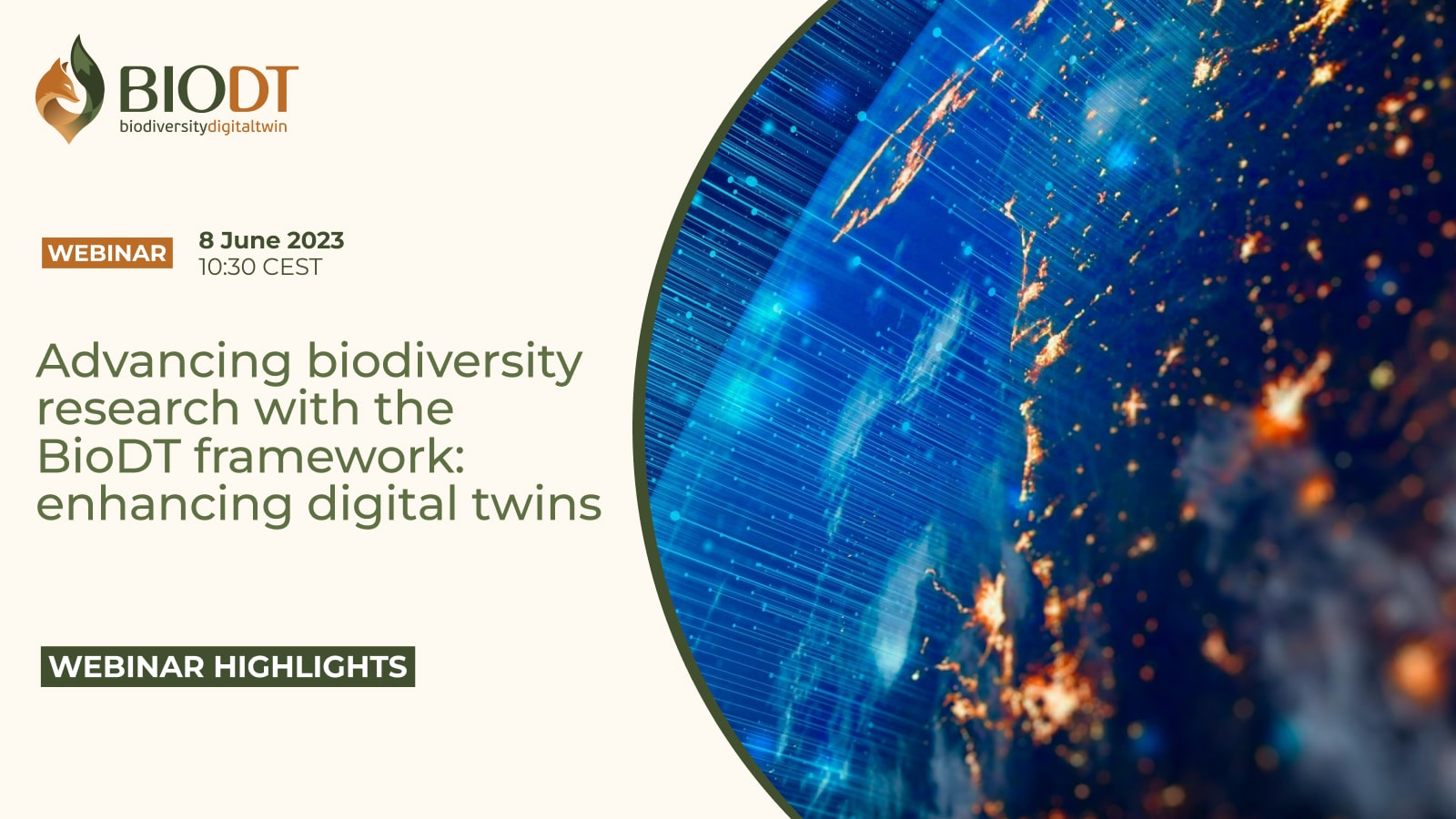
The overarching objectives of BioDT
Understanding the factors that shape biodiversity is essential for the rational management of natural resources and aligning with the objectives of the EU Biodiversity Strategy for 2030, which aims to restore biodiversity in Europe. Researchers face the challenging task of predicting global biodiversity dynamics and comprehending how species interact with their environment and each other. These dynamics are complex and require innovative approaches that combine data, models, and interaction processes to provide accurate predictions and sustainable solutions for managing Earth's biodiversity and ecosystems.
To address this challenge, the BioDT project aims to push the boundaries of predictive understanding of biodiversity dynamics by developing a cutting-edge prototype named Biodiversity Digital Twin (BioDT).
The Biodiversity Digital Twin prototype utilises advanced modelling, simulation, and prediction capabilities to accurately quantify and model the interactions between species and their environment. By leveraging existing technologies and data from relevant research infrastructures, BioDT aims to provide valuable insights into the changes in biodiversity, a mechanistic understanding of these changes, and predictions of their effects.
One year since its inception, the BioDT team has made progress in the technical advancements of its digital twin prototype. The outcomes of this work were recently unveiled during the engaging webinar "Advancing Biodiversity Research with the BioDT Framework: Enhancing Digital Twins," held on 8 June 2023.
BioDT: a technical digital twin platform prototype
The first speaker of the webinar was Tomas Martinovic, Senior Researcher at IT4I, who led the presentation on the technical infrastructure design for the BioDT prototype. Martinovic introduced the concept of a digital twin in the context of biodiversity and explained that it consists of data, models, and an application to generate relevant outputs. He emphasized the challenge of biodiversity data not being continually available in real-time and the need for multiple digital twins with different models.
The technical infrastructure, supported by BioDT, encompasses laptops, clouds, and servers, and exploits High-Performance Computing (HPC) resources and the Lumi supercomputer. Its goal is to enable users to interact with the digital twins using their laptops while computations can take place on Lumi or other cloud services. Martinovic acknowledged the differences between HPC and cloud services and the complexity of accessing HPC resources. He highlighted the importance of simplifying the process and providing a user-friendly interface.
Martinovic concluded his presentation by emphasizing the goal of providing users with seamless access to digital twins, shielding them from the underlying technical complexities. Due to this, the BioDT architecture aims to simplify resource management and enhance the user experience.
The role of HPC and LUMI Supercomputer in BioDT
Sergei Zaiaev, DevOps professional from the University of Tartu, followed Martinovic's presentation and provided more technical details on the role played by High-Performance Computing (HPC) and the Lumi supercomputer to build the digital twin prototype.
Zaiaev provided an insightful overview of the technical components utilised in the BioDT project. His focus was primarily on the crucial role played by the Lumi supercomputer. As an integral part of the project's infrastructure, Lumi facilitates resource allocation for BioDT services and workflows, enabling other components to allocate resources to specific users efficiently. Zaiaev further discussed future plans for dynamic resource allocation, emphasizing the project's goal of enhancing flexibility and efficiency in managing digital twins.
The role of Research Infrastructures in building BioDT
John Watkins, Researcher from the UK Centre of Ecology and Hydrology, delivered an informative presentation on the role of digital twinning in providing impact through the user community of research infrastructures involved in the BioDT project.
Watkins highlighted two specific areas of focus: biodiversity dynamics and cultural ecosystem services. In terms of biodiversity dynamics, he discussed the use of citizen science and mobile applications to record and predict migratory bird patterns, as well as the potential for data integration and model training using high-performance computing (HPC) capabilities. Watkins also explored the concept of cultural ecosystem services, emphasizing the importance of understanding how people interact with and derive well-being from the physical environment. He showcased examples, such as predicting recreational activities in national parks and utilising soundscapes to assess the quality of ecosystem services.
His presentation emphasized the need for HPC platforms to support the development and delivery of these capabilities. By leveraging digital twinning and incorporating diverse data sources, BioDT aims to enhance biodiversity research and contribute to the sustainable management of ecosystems.
Q&A and interactive session with the audience
The webinar concluded with an engaging Q&A session, allowing attendees to pose additional questions to Martinovic, Zaiaev, and Watkins. The speakers elaborated further on the topics covered in their presentations, providing in-depth explanations and insights. The interactive session fostered a deeper understanding of the subject matter and enhanced the overall knowledge-sharing experience of the webinar.
The event saw 50 attendees from 23 countries. During the webinar, the audience was asked a series of questions to test their familiarity with the technical topics covered during the live event. The following graphs show the main findings and takeaways from the surveys.
Both Q&A and interactive sessions were moderated by Rita Giuffrida, Researcher at Trust-IT Services.
Did you miss the webinar? Watch the recording on YouTube and download the slides!